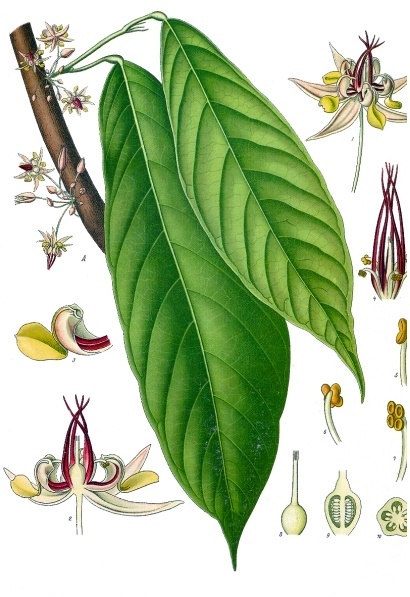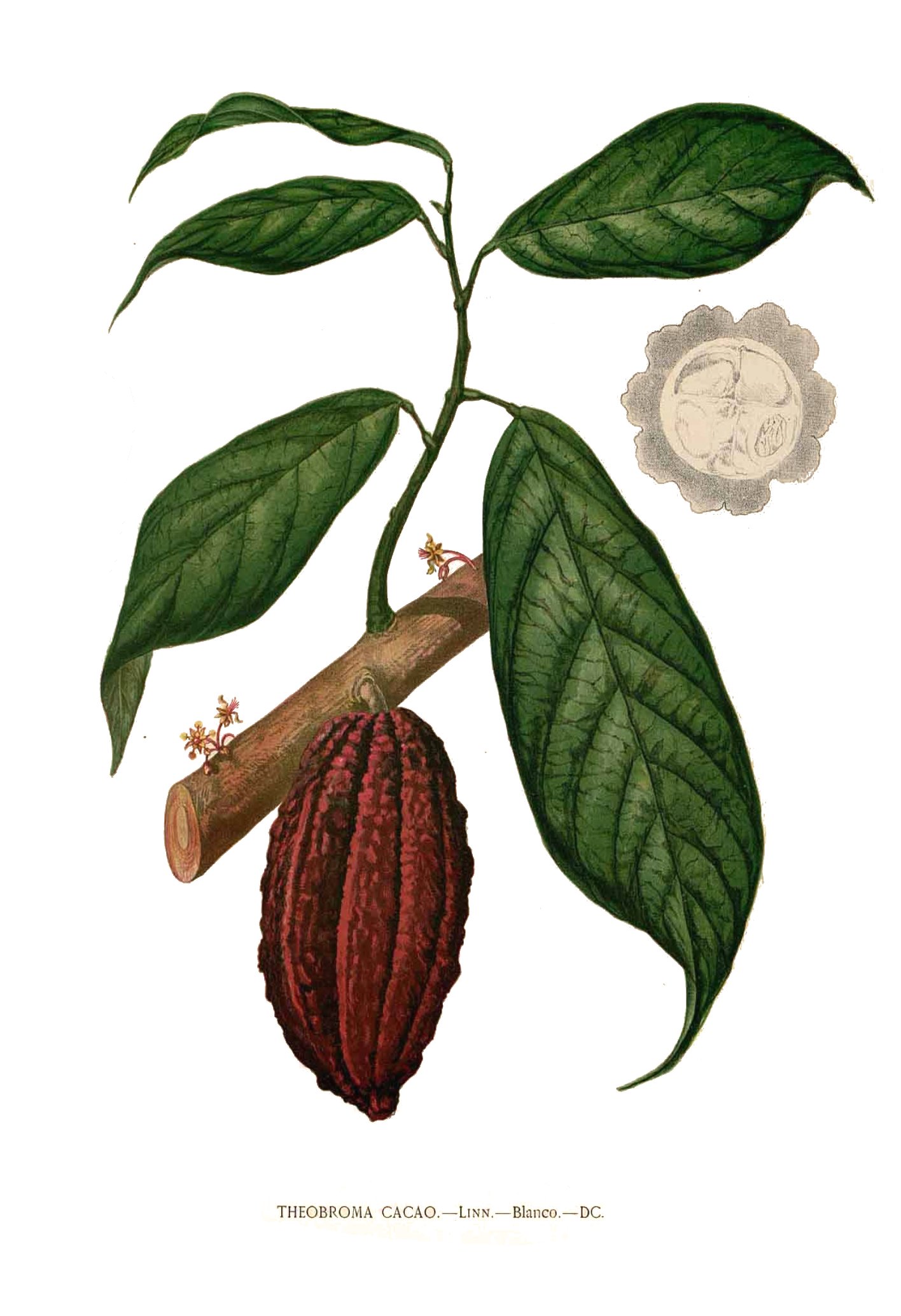Benutzer-Werkzeuge
Dies ist eine alte Version des Dokuments!
Theobroma cacao L. - Malvaceae - cacao tree, cocoa tree, Kakaobaum
Evergreen tree, up to 10m high (3-4m in culture), native to Central and South America; leaves simple, shiny dark green, leathery, up to 50cm long; flowers small, white or red, cauline; fruit a ridged green, yellow or purple berry, 10-20cm long and 5-10cm broad; fruit with many bean-shaped seeds, covered by a mucilaginous pulp.
„Cocoa beans (Theobroma cacao) are the major raw material for chocolate production and fermentation of the beans is essential for the development of chocolate flavor precursors. In this study, a novel approach was used to determine the role of yeasts in cocoa fermentation and their contribution to chocolate quality. Cocoa bean fermentations were conducted with the addition of 200 ppm Natamycin to inhibit the growth of yeasts, and the resultant microbial ecology and metabolism, bean chemistry and chocolate quality were compared with those of normal (control) fermentations. The yeasts Hanseniaspora guilliermondii, Pichia kudriavzevii and Kluyveromyces marxianus, the lactic acid bacteria Lactobacillus plantarum and Lactobacillus fermentum and the acetic acid bacteria Acetobacter pasteurianus and Gluconobacter frateurii were the major species found in the control fermentation. In fermentations with the presence of Natamycin, the same bacterial species grew but yeast growth was inhibited. Physical and chemical analyses showed that beans fermented without yeasts had increased shell content, lower production of ethanol, higher alcohols and esters throughout fermentation and lesser presence of pyrazines in the roasted product. Quality tests revealed that beans fermented without yeasts were purplish-violet in color and not fully brown, and chocolate prepared from these beans tasted more acid and lacked characteristic chocolate flavor. Beans fermented with yeast growth were fully brown in color and gave chocolate with typical characters which were clearly preferred by sensory panels. Our findings demonstrate that yeast growth and activity were essential for cocoa bean fermentation and the development of chocolate characteristics.“
[Yeasts are essential for cocoa bean fermentation. Van Thi Thuy Ho, Jian Zhao, Graham Fleet, International Journal of Food Microbiology, Vol.174, 2014, 72–87]
„The processing of cocoa seeds (Theobroma cacao, L.) comprises their drying, fermentation of sugars contained in the pulp covering the seeds, roasting, separation and grounding of the roasted nibs. The resulting fatty solid product (known as cocoa liquor) is the base raw material for chocolate industry. The most significant flavor-impact substances on cocoa derivatives are N- and O-containing heterocyclic compounds generated during the roasting, which are products of the complex sequence of heat-induced chemical processes collectively known as Maillard reactions. The substrates for the Maillard reactions are reducing sugars, small peptides, aminoacids and / or triglycerides contained in the raw, unroasted material. For cocoa, in terms of contribution to their sensorial characteristics (and, in consequence, to their commercial value), the most important Maillard reaction products are the alkylpyrazines. Considering their impact on the aroma, the ratios between the amounts of some alkylpyrazines on the volatile fraction of of cocoa and chocolate (the pyrazinic ratios) can be adopted as parameter for quality assessment of these products.“
[A Headspace Solid Phase Microextraction (HS-SPME) method for the chromatographic determination of alkylpyrazines in cocoa samples. Pini, G. F., Brito, E. S. D., García, N. H., Valente, A. L., Augusto, F., Journal of the Brazilian Chemical Society, Vol.15(2), 2004, 267-271] http://www.scielo.br/scielo.php?pid=S0103-50532004000200017&script=sci_arttext
„After vacuum distillation and liquid−liquid extraction, the volatile fractions of dark chocolates were analyzed by gas chromatography− olfactometry and gas chromatography− mass spectrometry. Aroma extract dilution analysis revealed the presence of 33 potent odorants in the neutral/basic fraction. Three of these had a strong chocolate flavor: 2-methylpropanal, 2-methylbutanal, and 3-methylbutanal. Many others were characterized by cocoa/praline-flavored/nutty/coffee notes: 2,3-dimethylpyrazine, trimethylpyrazine, tetramethylpyrazine, 3(or 2),5-dimethyl-2(or 3)-ethylpyrazine, 3,5(or 6)-diethyl-2-methylpyrazine, and furfurylpyrrole. Comparisons carried out before and after conching indicate that although no new key odorant is synthesized during the heating process, levels of 2-phenyl-5-methyl-2-hexenal, Furaneol, and branched pyrazines are significantly increased while most Strecker aldehydes are lost by evaporation.“
[Use of gas chromatography-olfactometry to identify key odorant compounds in dark chocolate. Counet, C., Callemien, D., Ouwerx, C., Collin, S., Comparison of samples before and after conching., Journal of agricultural and food chemistry, Vol.50(8), 2002, 2385-2391]
„A number of compounds have been identified by gas chromatography-olfactometry (GC-O) as key odorant compounds in dark chocolate. 2-Methylpropanal, 3-methylpropanal and 2-methylbutanal have been related to chocolate odors while trimethylpyrazine, 2,5-dimethylpyrazine and acetylpyrrole have been attributed cocoa odors. Methylpyrazine, 2,3-dimethylpyrazine, 2-ethyl-6-methylpyrazine and benzaldehyde added a hazelnut/almond note to the aroma profile of chocolate; ethylpyrazine, 3-ethyl-2,5-dimethylpyrazine and tetramethylpyrazine a roasty note.“
[Evaluation of solid-phase micro-extraction coupled to gas chromatography–mass spectrometry for the headspace analysis of volatile compounds in cocoa products. Ducki, S., Miralles-Garcia, J., Zumbé, A., Tornero, A., Storey, D. M., Talanta, Vol.74(5), 2008, 1166-1174]


